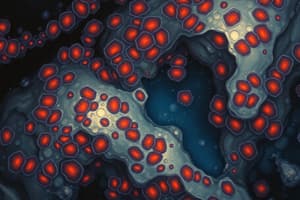Podcast
Questions and Answers
Which of the following is a known consequence of IL-6 signaling?
Which of the following is a known consequence of IL-6 signaling?
- Induction of apoptosis
- Suppression of growth and proliferation
- Activation of transcription factors (correct)
- Inhibition of transcription factors
The classical understanding of the restriction point primarily focuses on commitment to what cellular process?
The classical understanding of the restriction point primarily focuses on commitment to what cellular process?
- DNA repair
- DNA replication (correct)
- Transcription
- Mitosis
Which event is directly associated with commitment to DNA replication after the restriction point?
Which event is directly associated with commitment to DNA replication after the restriction point?
- Decreased activity of CDK2
- Inhibition of E2F-dependent transcription
- Hyperphosphorylation of Rb (correct)
- Dephosphorylation of Rb
Recent research has highlighted the importance of which metabolic process in regulating cell division?
Recent research has highlighted the importance of which metabolic process in regulating cell division?
How does inhibition of fatty acid synthase (FASN) affect the cell cycle?
How does inhibition of fatty acid synthase (FASN) affect the cell cycle?
What is the primary function of checkpoint kinases (CHK1 and CHK2) in cell cycle regulation?
What is the primary function of checkpoint kinases (CHK1 and CHK2) in cell cycle regulation?
How does p53 influence E2F-mediated gene transcription in response to DNA damage?
How does p53 influence E2F-mediated gene transcription in response to DNA damage?
Which mechanism stalls the cell cycle in G1 phase independently of p53 in the presence of DNA damage?
Which mechanism stalls the cell cycle in G1 phase independently of p53 in the presence of DNA damage?
AKT is implicated in various diseases. Which of the following conditions is NOT typically associated with AKT?
AKT is implicated in various diseases. Which of the following conditions is NOT typically associated with AKT?
What is a key characteristic of Proteus syndrome that distinguishes it from other overgrowth conditions?
What is a key characteristic of Proteus syndrome that distinguishes it from other overgrowth conditions?
Which of the following is a common characteristic of Ehlers-Danlos Syndrome (EDS)?
Which of the following is a common characteristic of Ehlers-Danlos Syndrome (EDS)?
Why is genetic counseling particularly recommended for individuals with Vascular Ehlers-Danlos Syndrome prior to family planning?
Why is genetic counseling particularly recommended for individuals with Vascular Ehlers-Danlos Syndrome prior to family planning?
What is the primary genetic mechanism associated with Duchenne Muscular Dystrophy?
What is the primary genetic mechanism associated with Duchenne Muscular Dystrophy?
Which of the following is a key characteristic of rhabdomyolysis?
Which of the following is a key characteristic of rhabdomyolysis?
Mutations in which type of collagen are primarily associated with Alport Syndrome?
Mutations in which type of collagen are primarily associated with Alport Syndrome?
Which genes are commonly implicated in Alport Syndrome, and what inheritance patterns do they exhibit?
Which genes are commonly implicated in Alport Syndrome, and what inheritance patterns do they exhibit?
How do mutations related to Alport Syndrome impact the basement membrane, and what are the functional consequences?
How do mutations related to Alport Syndrome impact the basement membrane, and what are the functional consequences?
What broader health concern is significantly associated with Alport Syndrome?
What broader health concern is significantly associated with Alport Syndrome?
Laminin-α2-related congenital muscular dystrophy (LAMA2-CMD) is also known as what?
Laminin-α2-related congenital muscular dystrophy (LAMA2-CMD) is also known as what?
Which of the following disorders is characterized by mutations affecting Gly-X-Y repeats in collagen?
Which of the following disorders is characterized by mutations affecting Gly-X-Y repeats in collagen?
Which of the following signaling pathways, when activated, would lead to an increase in intracellular cAMP levels due to a loss of regulation, similar to the effect of Pertussis toxin?
Which of the following signaling pathways, when activated, would lead to an increase in intracellular cAMP levels due to a loss of regulation, similar to the effect of Pertussis toxin?
A researcher is studying a cell line with a mutation that causes constitutive activation of adenylyl cyclase. Which of the following downstream effects is most likely to be observed in these cells?
A researcher is studying a cell line with a mutation that causes constitutive activation of adenylyl cyclase. Which of the following downstream effects is most likely to be observed in these cells?
Cholera toxin modifies a G protein such that it is constitutively active. What is the direct effect of this modification inside intestinal cells?
Cholera toxin modifies a G protein such that it is constitutively active. What is the direct effect of this modification inside intestinal cells?
Which of the following best describes the role of E2F in cell cycle regulation?
Which of the following best describes the role of E2F in cell cycle regulation?
A researcher observes that a cell line has a mutation preventing Rb phosphorylation. What is the most likely consequence of this mutation?
A researcher observes that a cell line has a mutation preventing Rb phosphorylation. What is the most likely consequence of this mutation?
Consider a scenario where a cell experiences DNA damage. How does p53 respond to this damage to regulate the cell cycle?
Consider a scenario where a cell experiences DNA damage. How does p53 respond to this damage to regulate the cell cycle?
A scientist introduces a non-functional form of the p21 protein into cells. What is the likely outcome regarding the cell cycle regulation, especially under conditions of DNA damage?
A scientist introduces a non-functional form of the p21 protein into cells. What is the likely outcome regarding the cell cycle regulation, especially under conditions of DNA damage?
Considering the roles of CHK1 and CHK2 in cell cycle regulation, what would be the most likely consequence of a mutation that inactivates both CHK1 and CHK2?
Considering the roles of CHK1 and CHK2 in cell cycle regulation, what would be the most likely consequence of a mutation that inactivates both CHK1 and CHK2?
How do peptide hormones such as insulin contribute to cell growth and proliferation?
How do peptide hormones such as insulin contribute to cell growth and proliferation?
Which of the following mechanisms directly regulates the activity of E2F?
Which of the following mechanisms directly regulates the activity of E2F?
Flashcards
IL-6 Signaling Consequences
IL-6 Signaling Consequences
A cytokine that promotes growth, proliferation and inhibits apoptosis through activation of transcription factors.
Restriction Point
Restriction Point
A critical G1 checkpoint where, once passed, the cell is committed to DNA replication.
Events at the Restriction Point
Events at the Restriction Point
Hyperphosphorylation of Rb protein, activation of E2F-dependent transcription, and increased activity of CDK2.
Cell Division Regulators
Cell Division Regulators
Signup and view all the flashcards
Fatty Acid Metabolism in Cell Cycle
Fatty Acid Metabolism in Cell Cycle
Signup and view all the flashcards
Cellular Division Regulation
Cellular Division Regulation
Signup and view all the flashcards
Checkpoint Kinases (CHK1/2)
Checkpoint Kinases (CHK1/2)
Signup and view all the flashcards
P53 Role in Cell Cycle
P53 Role in Cell Cycle
Signup and view all the flashcards
AKT-Related Diseases
AKT-Related Diseases
Signup and view all the flashcards
AKT
AKT
Signup and view all the flashcards
Adenylate Cyclase
Adenylate Cyclase
Signup and view all the flashcards
G-protein Coupled Signaling
G-protein Coupled Signaling
Signup and view all the flashcards
Phospholipase C
Phospholipase C
Signup and view all the flashcards
CREB
CREB
Signup and view all the flashcards
Pertussis Toxin
Pertussis Toxin
Signup and view all the flashcards
Cholera Toxin
Cholera Toxin
Signup and view all the flashcards
p53
p53
Signup and view all the flashcards
pRb
pRb
Signup and view all the flashcards
p21
p21
Signup and view all the flashcards
E2F
E2F
Signup and view all the flashcards
Ehlers-Danlos Syndrome (EDS)
Ehlers-Danlos Syndrome (EDS)
Signup and view all the flashcards
Joint Hypermobility in EDS
Joint Hypermobility in EDS
Signup and view all the flashcards
Vascular Ehlers-Danlos Syndrome
Vascular Ehlers-Danlos Syndrome
Signup and view all the flashcards
Duchenne Muscular Dystrophy
Duchenne Muscular Dystrophy
Signup and view all the flashcards
Dystrophin
Dystrophin
Signup and view all the flashcards
Rhabdomyolysis
Rhabdomyolysis
Signup and view all the flashcards
Alport Syndrome
Alport Syndrome
Signup and view all the flashcards
COL4A5, COL4A3, COL4A4
COL4A5, COL4A3, COL4A4
Signup and view all the flashcards
Impact of Alport Syndrome
Impact of Alport Syndrome
Signup and view all the flashcards
Laminin-α2-related CMD
Laminin-α2-related CMD
Signup and view all the flashcards
Study Notes
- The lecture is titled "Cellular Regulation and Case Presentations" for Block 2 Flipped Classroom.
Objectives
- Identify molecules and match their activity to steps in cell cycle regulation
- Examples include p53, pRb, p21, E2F and E2F promoter, CHK1 and CHK2, cyclins, CDKs, cyclin/CDK complexes, and INK4 family
- Assess the consequence for cellular division and/or molecular processes for changes in the following: binding at E2F promoter, Rb phosphorylation, cyclin availability, p53 activity, p21 activity, and INK4 family activity.
- Link changes in signaling with additional disorders; summarize features of disorders including cancer and proteus syndrome.
- Recognize clinical consequences for changes in cellular components.
- Connect the condition with the altered pathways/processes; identify clinical features of the condition.
G-Protein Coupled Signaling
- G-protein coupled signaling involves the activation of various downstream effectors.
- Phospholipase C activation leads to the production of inositol triphosphate and diacylglycerol (DAG).
- Inositol triphosphate increases calcium levels, activating calcium channels and nitric oxide synthase.
- Adenylate cyclase activation by GTP leads to cAMP production.
- cAMP activates protein kinase A (PKA).
- PKA phosphorylates CREB and allows translocation of the active subunit to the nucleus for transcription.
Pertussis Toxin
- Pertussis toxin alters cAMP activity by disrupting inhibitory regulation.
- Pertussis toxin (PTX) causes an increase in cAMP activity due to loss of inhibition/regulation.
- This leads to inhibition of AC activity and stimulation of cAMP-mediated signaling.
Cholera Toxin
- Cholera toxin alters cAMP activity by constitutive activation of adenylate cyclase.
- This leads to stimulation of cAMP-mediated signaling.
Proliferative Signaling
- Proliferative signaling in natural, regulated systems require signals for cell growth and division.
- This includes peptide hormones like insulin, growth factors such as epidermal growth factor, and cytokines like IL-6.
- Consequences of signaling include activation of transcription factors, growth/proliferation, and anti-apoptosis.
- AKT is a common mediator, linked to insulin, integrin, and PI3K.
Restriction Point
- The restriction point, classically known as the G1 checkpoint.
- After this point commitment to the cell cycle occurs, the cell commits to DNA replication
- Newer evidence questions the timing of no return but the steps associated are clear.
- Commitment to DNA replication involves hyperphosphorylation of Rb, activation of E2F-dependent transcription, and increased CDK2 activity.
- Hyperphosphorylation of Rb in cells re-entering the cell cycle from quiescence enables DNA synthesis and progression.
G1 to S Transition
- Mitogen activity/availability regulates cell division, and DNA damage/fidelity are critical regulators.
- Fatty acid metabolism regulates cell division.
- Lipid synthesis is required for cell division, conflicting evidence whether lipid checkpoint exists
- Fatty acid synthase (FASN) activity is connected to cell death.
- Inhibition of fatty acid metabolism in G1 inhibits entry into S phase.
- Fatty acid synthase blockers can prevent S phase entry, even when stimulated with growth factor.
Regulation of Cellular Division
- Control of cellular division is critical. Multiple steps include activating phosphorylation or inactivation.
- Checkpoint kinases include CHK1 and CHK2, increase p21 levels or by inhibiting CDC25 phosphatases.
- P53 is a DNA damage sensor.
- It acts as a transcription factor for p21, inhibiting cyclin D/CDK4 and preventing Rb phosphorylation.
- INK4 family has a p53-independent mechanism for G1 stalling in the presence of DNA damage.
Signal Mediators and Disease
- AKT is a common signal mediator.
- AKT genes are associated with cancer, cardiovascular disorders, diabetes, and neurological disorders.
- AKT1 overexpression is linked to cancer development and expression.
- AKT1 plays a role in cardioprotective processes that support growth and function.
- Pathogenic AKT1 variation can lead to tissue overgrowth.
- Proteus syndrome is a rare condition that can be caused by AKT1, characterized by overgrowth of bone, skin, and tissues.
- Growth in Proteus syndrome is asymmetrical.
- AKT1 mutations are common but not believed to be inherited; the condition develops due to mitotic error during early development.
Linking Human Disease
- The following conditions are a summary of the presentation: Ehlers-Danlos Syndromes, Duchenne muscular dystrophy, Rhabdomyolysis, Alport Syndrome, Laminins and Muscular Dystrophy, and ẞ-Thalassemia
Ehlers-Danlos Syndrome
- Ehlers-Danlos Syndrome is a group of 13 heritable connective tissue disorders, hypermobile EDS is common.
- Hallmarks are overly flexible joints and stretchy, fragile skin.
- Vascular Ehlers-Danlos syndrome is more severe, with of vascular/intestinal/uterine ruptures.
- Collagen and associated genes (affect collagen structure/function) are implicated.
Duchenne Muscular Dystrophy
- Duchenne muscular dystrophy is an X-linked recessive disorder more frequent in males than females.
- Incidence of one in 3600 live born males.
- It's the most common hereditary neuromuscular disease
- Causes progressive muscle degeneration.
- Symptoms appear prior to age six and life expectancy is reduced
- Therapeutics are centered around management of symptoms and improving quality of life
- Impacts the protein dystrophin, connection of intracellular with ECM
Rhabdomyolysis
- Damaged muscle releases proteins and electrolytes into blood.
- Marked creatine kinase elevation is observed.
- Mechanisms relate to ion movement, ROS, mitochondrial dysfunction, and lipid peroxidation.
Alport Syndrome
- Involves mutations in type IV collagen affecting production and deposition; 80% are COL4A5 on X chromosome.
- Impacts basement membrane in glomerulus, cochlea, and eye.
- Can weaken the basement membrane making it sensitive to proteolytic enzymes
- Significant cause of chronic kidney disease.
Laminins and Muscular Dystrophy
- Laminin-a2-related congenital muscular dystrophy (LAMA2-CMD) results in merosin deficient congenital muscular dystrophy type 1A (MDC1A).
- Mutations in LAMA2 gene (encodes laminin-a2 protein).
- Laminin-a2 is essential for assembly of laminin-211 and laminin-221.
- Disrupts communication between basal lamina and muscle membrane.
- Connection with integrins is affected.
Beta-Thalassemia
- Characterized by absent or markedly decreased accumulation of globin subunits of hemoglobin
- Beta-Thalassemias involve the beta-globin subunits.
- Over 200 different mutations have been identified.
- Mutations in beta subunits reduce their availability.
- Excess accumulation of alpha subunits occurs as they are unable to bind beta subunits.
- Homozygous-affected and compound heterozygous individuals have severe, hemolytic anemia.
Studying That Suits You
Use AI to generate personalized quizzes and flashcards to suit your learning preferences.




